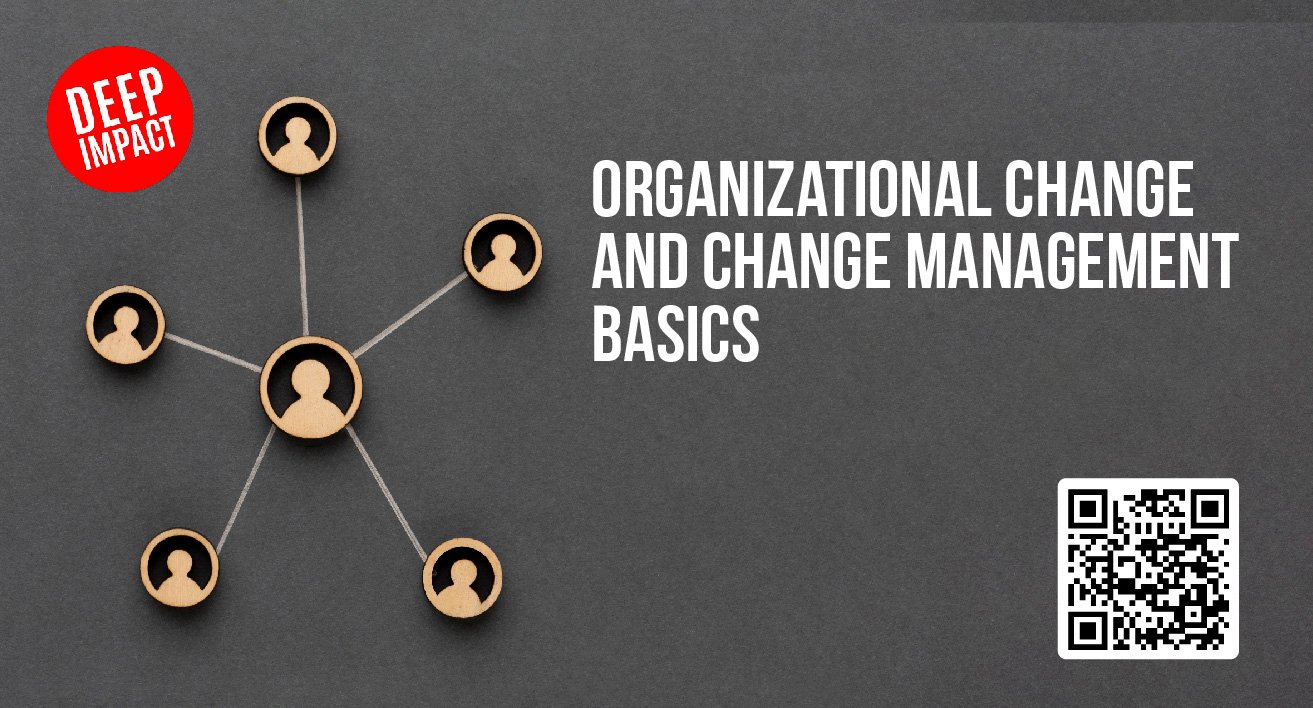In today’s fast-moving business world, change isn’t just inevitable—it’s happening faster than ever. From technological advancements to sudden market shifts, businesses are under constant pressure to adapt. The COVID-19 pandemic is a prime example, acting as a global reset that forced companies to rethink their operations almost overnight. Many organizations had to swiftly adopt new ways of working, engage with customers in entirely new formats, and overhaul their supply chains—all of which required strong change management strategies to ensure they could keep up with the pace of disruption.
This article will dive into the fundamentals of change management, why it’s crucial for any organization, and the common challenges that often arise during the process.
What is Organizational Change?
Organizational change refers to the processes through which a company or organization alters its structures, strategies, operational methods, technologies, or organizational culture. These changes can be incremental (small, continuous improvements) or transformational (large-scale shifts that fundamentally change the organization).
Key Drivers of Organizational Change:
Essentially, there are several key drivers that drive organizational change. These drivers are divided into two, external factors and internal factors. Below are the key drivers of organizational change, both internally and externally:
| Internal Factors | External Factors |
|---|---|
| Leadership Changes: New Leadership brings different visions or strategies. | Technological Advancement: Adoption of new Technologies to stay competitive. |
| Mergers and Acquisitions: Integrating different organizational cultures and systems. | Market Conditions: Responding to shifts in customer preferences or economic environments. |
| Strategic Shifts: Realigning business objectives to pursue new opportunities. | Regulatory Requirements: Complying with new laws or industry standards. |
- External Factors:
- Technological Advancements: Adoption of new technologies to stay competitive.
- Market Conditions: Responding to shifts in customer preferences or economic environments.
- Regulatory Requirements: Complying with new laws or industry standards.
- Internal Factors:
- Leadership Changes: New leadership brings different visions or strategies.
- Mergers and Acquisitions: Integrating different organizational cultures and systems.
- Strategic Shifts: Realigning business objectives to pursue new opportunities.
Each of the drivers of organizational change can occur differently in each organisation. Therefore, a leader must understand every situation that occurs internally and externally so that they can take the right steps in organizational change.
Understanding what constitutes organizational change is crucial because it forms the foundation of change management. It sets the stage for implementing change management strategies that ensure these transitions are smooth, effective, and sustainable.
What is Change Management?

Change management involves preparing, supporting, and assisting individuals, teams, and organizations through the process of change.
It involves managing the human side of change to achieve the desired outcome. This could involve anything from adopting new technologies and processes to shifting organizational culture.
The goal of change management is implementing change in a way that enables the transition as smooth as possible, minimizing resistance and maximizing engagement among all stakeholders.
Key Components of Change Management:
- Planning: Developing a clear strategy and roadmap for the change initiative.
- Communication: Ensuring transparent and consistent messaging to key stakeholders.
- Training and Support: Providing the necessary resources and education to facilitate the change.
- Monitor progress and Feedback: Continuously assess the progress and make adjustments as needed.
- Reinforcement: Sustain the change by embedding it into the organizational culture.
Challenges and Success Factors: While change management is crucial for the success of any change initiative, it’s not without challenges. Success rates can vary widely depending on factors such as leadership effectiveness, employee engagement, communication, and the organization’s adaptability. Studies have shown that organizations prioritising these elements in their internal processes tend to achieve success faster.
Organizational Change vs. Change Management: Clearing the Confusion
It’s common to confuse organizational change with change management because they are closely related concepts. However, they serve different purposes within the context of an organization’s evolution. Below is a comparison table to delineate the differences:
| Aspect | Organizational Change | Change Management |
|---|---|---|
| What It Is | The actual modifications or transformations within the organization (e.g., restructuring departments, implementing new technologies). | The methodologies and processes used to manage the transition associated with organizational change. |
| Focus | The end result or the "what" of change. | The process and the "how" of implementing change |
| Example | A company deciding to move from a traditional office setup to a remote work model. | Developing a communication plan, training employees on new remote work tools, and addressing concerns related to the transition. |
Why the Distinction Matters
Grasping the difference between organizational change and change management isn’t just a nice-to-know—it’s a must for leaders who want to drive successful transitions.
- Organizational Change zeroes in on what’s changing within the business, whether it’s rolling out new technology, restructuring teams, or shifting strategies.
- Change Management, on the other hand, focuses on how you help people through those changes, ensuring that employees not only understand what’s happening but feel equipped and supported throughout the process.
Here’s why understanding both sides of the equation is critical:
- Clarity in Strategy: Knowing the difference allows organizations to plan smarter. It ensures that the change itself—whether a new system or a business model overhaul—and the process of managing it both get the attention they deserve.
- Resource Allocation: By clearly distinguishing between what’s changing and how it’s being managed, you can allocate resources more effectively. This means ensuring the right support, training, and tools are in place to manage the transition smoothly.
- Enhanced Communication: When everyone knows not just what’s changing but how it’s being handled, communication becomes clearer across the organization. Employees understand the process, timelines, and their role, reducing confusion and resistance.
Leaders who can differentiate between organizational change and change management are far better equipped to plan, execute, and sustain change successfully. By addressing both what is changing and how to manage that change, you create a smoother path forward for their teams.
Types of Change Management
Change management isn’t a one-size-fits-all approach. Depending on the nature of the change, different change management strategies may be required. Here are the two main types:
- Transformational Change: This involves radical shifts in an organization’s operations, culture, or structure. For example, Netflix’s transition from a DVD rental service to a streaming platform required a complete overhaul of its business model.
- Incremental Change: This involves smaller, more gradual adjustments. A notable example is Apple’s approach to product development. Rather than making drastic changes to their products all at once, Apple has consistently focused on incremental improvements. With each new version of the iPhone, Apple introduces enhancements in design, functionality, and technology. These changes are often subtle but accumulate over time to create a significantly improved product. This method allows Apple to continuously innovate while maintaining user familiarity and loyalty, without overwhelming employees or customers with drastic changes.
Both types of change require a thoughtful strategy. With transformational change, you’ll need a more structured, hands-on approach to guide your team. Incremental changes allow for a more fluid process, focusing on continuous improvement without overwhelming your workforce.
The Importance of Change Management in Modern Organizations

Why is change management so important? In today’s fast-paced business landscape, organizations that can’t adapt get left behind.
Beyond minimizing disruption, successful change programs can significantly enhance an organization’s agility, enabling it to respond quickly to market changes. A survey by Prosci found that organizations with an effective change management methodology are 59% more likely to be effective than those without.
Here are the areas where it helps:
1. Minimize Disruptions
High-Level Overview: Change often brings uncertainty and anxiety. Effective change management provides a structured approach that helps stakeholders understand and accept changes, thus overcoming resistance and confusion.
Detailed Application: A well-structured change management process ensures that transitions are less disruptive. By focusing on clear communication and stakeholder engagement, organizations can guide their teams through change with minimal friction, leading to smoother transitions and better outcomes.
2. Boosting Employee Engagement
High-Level Overview: Effective change management boosts employee engagement by addressing the “how” of change, ensuring employees feel comfortable, supported, and enable action during transitions.
Detailed Application: By aligning change efforts with employee needs and providing the necessary support, organizations can foster a more resilient and agile workforce. This approach not only boosts morale but also builds a foundation for better workflows, as employees are more willing and able to adapt to new processes and technologies.
3. Maximizing ROI
High-Level Overview: Research indicates that organizations with strong change management practices can see returns 2 to 3 times higher on their change initiatives. This is because effective change management ensures that changes are fully adopted and integrated into the organization.
Detailed Application: A solid change management approach allows management teams to set actionable goals and utilize resources more effectively. By planning thoroughly and managing the process carefully, organizations leading change can achieve their objectives on schedule and within budget, thus maximizing their return on investment.
4. Reducing Resistance to Change
High-Level Overview: Effective change management significantly reduces resistance, making it easier to implement new strategies and processes. Organizations with good change management practices report lower levels of resistance among people affected.
Detailed Application: Change management helps in creating a standardized approach that addresses the concerns of all employees. By involving them early in the process and providing clear, consistent communication, resistance can be minimized, increasing buy-in; leading to smoother implementation and better project outcomes.
5. Avoiding the Cost of Failure
High-Level Overview: Poor change management can lead to failed initiatives, resulting in wasted time, money, and resources. By investing in structured change management, organizations can avoid these pitfalls and generate short-term wins.
Detailed Application: Continuous improvement in change management processes is crucial for long-term success. Developing a standardized and systematic approach not only helps in the current change initiative but also builds a framework for handling future changes more effectively.
Real-Life Case: Ford Motor Company, under CEO Alan Mulally, is a prime example of successful change management. Facing potential bankruptcy in 2006, Ford underwent a significant restructuring and strategic shift. By implementing a clear change management plan, Mulally was able to align the company’s leadership, employees, and resources with the new strategy, ultimately saving the company from collapse and driving it back to profitability.
The Role of Leadership in Successful Change

Leadership is at the heart of any successful change management process. Strong business leaders not only guide the organization through the change process and change projects but also inspire and motivate employees to embrace the new direction. Effective business leaders communicate the vision clearly, address concerns empathetically, and ensure that the organization remains focused on its goals throughout the transition.
Real-Life Case: Different leadership styles can significantly impact the success of change initiatives
Different leadership styles of senior executives can significantly impact the success of change initiatives:
Transformational leaders, like Howard Schultz of Starbucks, inspire and motivate their teams by painting a compelling vision of the future. Schultz’s leadership style was instrumental in driving Starbucks’ global expansion, as he emphasized the importance of maintaining the company culture and values even as it scaled.
Transactional leaders focus on clear structures and rewards, ensuring that employees understand their roles in the change process and the business change it needs. Jack Welch, former CEO of General Electric, exemplified this style, successfully implementing Six Sigma across GE’s operations, which resulted in substantial efficiency gains.
Laying the Foundation for Change

Understanding the basics of change management is the first step toward implementing successful change initiatives in your organization. By recognizing the importance of managing the human side of change, addressing common challenges and leveraging strong leadership, you can ensure that your organization is well-prepared to navigate the complexities of change.
Investing in change management is not just about navigating the challenges of today; it’s about preparing your organization for the uncertainties of tomorrow.
As businesses continue to evolve in an increasingly complex world, those that can adapt quickly and effectively will be the ones that thrive.
Take the time to review your strategic vision, assess your current change management practices and consider how they can be strengthened.
Whether you’re planning a major transformation or a minor adjustment, a structured approach to change management can make all the difference in achieving your goals and securing long-term success.
Looking for a Change Management Approach that Fits for Your Team or Organization?
If you’re considering making changes and maintaining momentum towards important outcomes, get in touch to discuss how we can help your transformation efforts.







